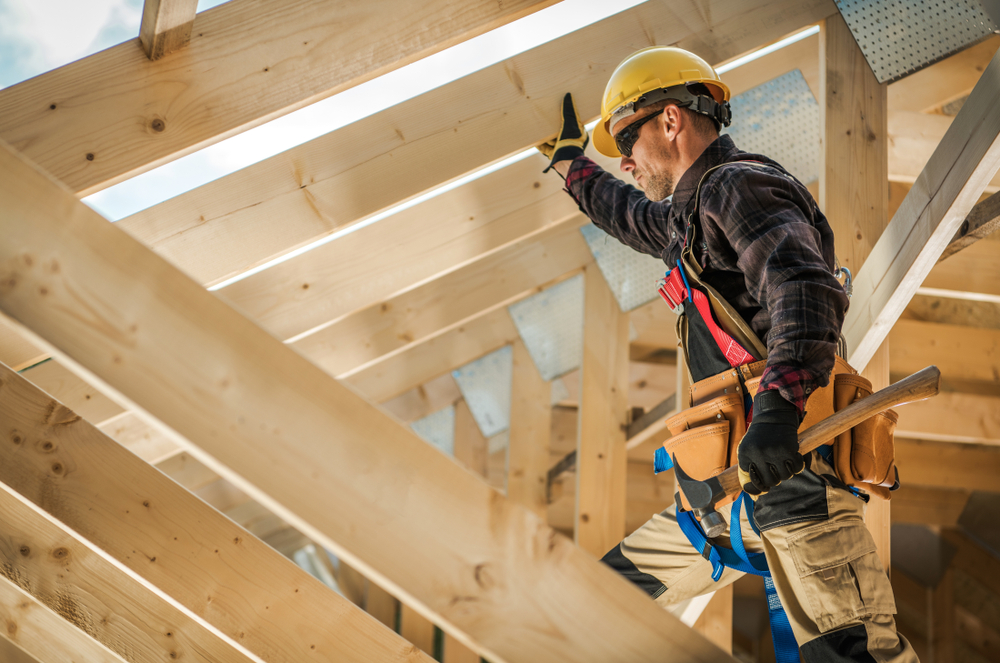Wood is a versatile and essential material used in various applications, from construction to furniture-making. Understanding the differences between hardwood and softwood is crucial for selecting the right types of wood for interior design projects. This blog post delves into the definitions, physical characteristics, durability, uses, cost, availability, and environmental impact of hardwood and softwood.

Hardwood vs Softwood: Key Differences
Hardwood lumber comes from deciduous trees that lose their leaves annually, such as an oak tree like red oak, maple, and walnut. Hardwood trees typically grow slower, resulting in denser and more durable wood.
This density makes hardwoods particularly resistant to wear and damage, making them ideal for high-traffic areas and applications where longevity is essential. The slower growth rate also contributes to the unique and often intricate grain patterns found in hardwoods, adding to their aesthetic appeal.
Softwood lumber, on the other hand, comes from coniferous trees, like pine, spruce, and Douglas fir, which usually have needles and cones. Softwood trees grow faster, making the wood less dense and generally softer than hardwood. This lower density makes softwoods easier to cut, shape, and work with, which is why they are often used in construction and manufacturing.
Despite being softer, many softwoods are still quite strong and durable, making them suitable for structural applications. The faster growth rate of softwoods also means they are more readily available and often less expensive than hardwoods, making them a practical choice for a wide range of projects.
Origins and Sources of Hardwood Trees and Softwood Trees
Hardwood trees primarily come from temperate and tropical forests around the world. Common regions for hardwood trees include North America, South America, Europe, and Asia. Softwood trees like Douglas fir are predominantly found in the Northern Hemisphere, particularly in North America and Europe.
Hardwoods derive from angiosperm trees while softwoods come from gymnosperm trees, like conifers. Softwood trees grow seed-filled cones that are carried by the air and rain. Pine trees, for example, are considered a softwood because they produce seed-filled cones.
Differences in Physical Characteristics Between Hardwood Trees and Softwood Trees
Grain Patterns
Hardwoods tend to have a more complex and attractive grain pattern compared to softwood. This makes hardwood a popular choice for furniture and decorative pieces. The intricate grain patterns in hardwoods like oak, walnut, and cherry add a level of sophistication and uniqueness to each piece, making hardwood veneer highly desirable for high-end applications.
Color Variations
Hardwood tends to have a wider range of natural colors, from light beech to dark mahogany. This variety allows for greater flexibility in design and aesthetics, catering to different tastes and styles. Softwood usually has lighter colors, such as pale yellow or light brown, which can be easily stained or painted to match various decor themes.
Density and Weight
The hardwood species is generally denser and heavier than softwood. This density contributes to its durability and strength, making it suitable for high-traffic areas and heavy-use furniture. The higher density of hardwoods also means they are more resistant to dents and scratches, which is why they are often used in flooring and other applications where durability is crucial. Softwoods, being lighter and less dense, are easier to handle and work with, making them ideal for construction and projects that require a lot of cutting and shaping.
Durability and Longevity of Hardwood Lumber
Resistance to Wear and Tear
Hardwood is more resistant to scratches, dents, and general wear and tear compared to softwood. This makes most hardwoods ideal for flooring, cabinetry, and furniture that will see a lot of use.
Suitability for Indoor vs. Outdoor Use
Hardwood is often preferred for indoor applications due to its durability and aesthetic appeal. However, certain hardwoods like teak and ipe are also suitable for outdoor construction projects and garden furniture due to their natural resistance to moisture and insects. Softwood, while less durable, can be treated to enhance its resistance to the elements, making it suitable for outdoor structures like decks and fences.
Uses and Applications of Hardwood vs Softwood
Hardwood lumber is commonly used for flooring, luxury furniture, carpentry, cabinetry, and decorative items. Its durability and attractive grain make it a preferred choice for items that require strength and beauty.
- Flooring: Hardwood floors are highly sought after for their longevity, aesthetic appeal, and ability to be refinished multiple times. Woods like oak, maple, and cherry are popular choices for high-traffic areas due to their hardness and resistance to wear.
- Furniture: High-end furniture often utilizes hardwoods for their strength and intricate grain patterns. Woods such as mahogany, walnut, and teak are favored for crafting elegant tables, chairs, and cabinets that can become heirloom pieces.
- Carpentry Cabinet: Hardwood is the material of choice for custom cabinetry and detailed carpentry work. Its ability to hold intricate designs and finishes makes it ideal for kitchen cabinets, built-in bookshelves, and other custom woodwork.
- Decorative Items: The unique grain and color variations of hardwood make it perfect for decorative items like picture frames, sculptures, and musical instruments. The natural beauty of hardwood can add a touch of sophistication to any space.
Common Uses for Softwood Species
Softwood lumber is often used in construction, including timber-framed buildings, roofing, and paneling. It is also used for making paper, plywood, and medium-density fiberboard (MDF). Softwood’s light weight and ease of workability make it an incredibly versatile resource for many projects.
- Construction: Softwood is the backbone of the construction industry. It is widely used for structural framing, roof trusses, and wall studs due to its availability, cost-effectiveness, and ease of use. Pine and spruce are common choices for these applications.
- Paneling and Cladding: Softwood is frequently used for interior and exterior paneling and cladding. Its natural look and ease of staining or painting make it a versatile option for both rustic and modern designs.
- Paper and Pulp Products: Softwood fibers are longer and more flexible, making them ideal for producing paper and pulp products. The wood is processed into pulp, which is then used to manufacture various types of paper, including newsprint and cardboard.
- Plywood and MDF: Softwood is a primary material for engineered wood products like plywood and MDF. These materials are used in a wide range of applications, from furniture making to construction, due to their strength, stability, and cost-effectiveness.
- DIY Projects: Softwood’s workability makes it a favorite for DIY enthusiasts. It is easy to cut, shape, and join, making it suitable for a variety of home improvement projects, from shelving units to garden furniture.

Cost and Availability of Hardwood vs Softwood
Comparative Cost Analysis of Hardwood vs Softwood
Generally, hardwood is more expensive than softwood due to its slower growth rate and greater density. The cost can vary significantly depending on the type of wood and its availability. For example, exotic hardwoods like mahogany or teak can be significantly more expensive than domestic hardwoods like oak or maple.
The labor-intensive process of harvesting and milling hardwood also contributes to its higher cost. In contrast, softwoods like pine and spruce are more affordable due to their faster growth rates and ease of processing. This makes softwood a cost-effective option for large-scale construction projects and applications where budget constraints are a concern.
Market Availability of Hardwood vs Softwood
Softwood is more readily available than its hardwood counterparts and tends to be less expensive due to the faster growth rate of coniferous trees. Softwoods are commonly found in large quantities in regions with extensive coniferous forests, such as North America and Northern Europe. This abundance ensures a steady supply and lower prices. Additionally, the versatility of softwood makes it a staple in the construction industry, further driving its widespread availability.
Hardwood, while more limited in supply, is available in a wide range of species, each with unique characteristics and price points. The availability of hardwood can be influenced by factors such as regional forestry practices, environmental regulations, and market demand. For instance, certain hardwoods may be more accessible in specific regions, like walnut in North America or teak in Southeast Asia. The limited supply and higher demand for certain hardwood species can drive up prices, making them a premium choice for specialized applications like fine furniture and high-end flooring.
While hardwood offers unparalleled beauty and durability, its higher cost and limited availability make it a more exclusive option. Softwood, with its affordability and abundance, remains a practical choice for a wide range of applications, particularly in construction and everyday woodworking projects.
Sustainability and Environmental Impact
Sourcing and Forestry Practices
Sustainable forestry practices are essential for both hardwood and softwood to ensure the long-term health of forests. Certification programs like FSC (Forest Stewardship Council) and PEFC (Programme for the Endorsement of Forest Certification) help consumers identify sustainably-sourced wood. These certifications ensure that the wood is harvested in a manner that maintains the biodiversity, productivity, and ecological processes of the forest.
Sustainable practices include selective logging, where only certain trees are harvested, and clear-cutting is avoided to preserve the forest structure. Additionally, reforestation and afforestation efforts are crucial in replacing harvested trees and expanding forested areas.
Comparative Environmental Footprint
Softwood generally has a lower environmental footprint due to the faster growth rate of coniferous trees, which can be harvested and replanted more quickly. This rapid growth cycle means that softwood forests can recover more swiftly from logging activities, making them a more renewable resource. However, sustainably managed hardwood forests can also provide significant environmental benefits.
Hardwood trees, with their longer growth cycles, can sequester more carbon over their lifetimes, contributing to climate change mitigation. Furthermore, hardwood forests often support a higher level of biodiversity, providing habitats for various plant and animal species. The key to minimizing the environmental impact of both hardwood and softwood is responsible forest management that balances economic needs with ecological preservation.
By choosing certified wood products, consumers can support sustainable forestry practices and help protect forest ecosystems for future generations.
An Experienced Interior Designer Can Transform Your Home Using Hardwood Lumber or Softwood Lumber
Both hardwood and softwood have unique characteristics, advantages, and applications. Hardwood is denser, more durable, and often more visually appealing, making it ideal for high-quality furniture and flooring. Softwood is lighter, easier to work with, and more cost-effective, making it suitable for construction and everyday applications.
When choosing between hardwood and softwood, consider the specific needs of your project, budget, and environmental impact. For expert advice and high-quality materials, consider hiring our Elmhurst, IL interior designer to help you make the best choice for your home or project.
